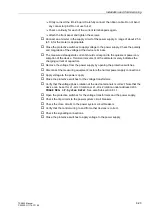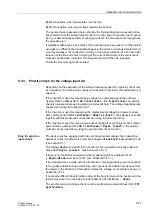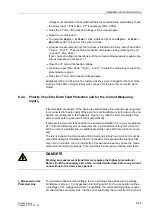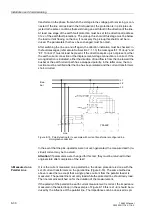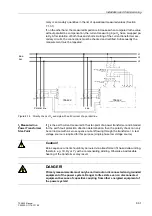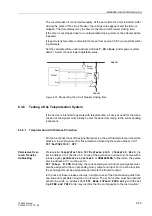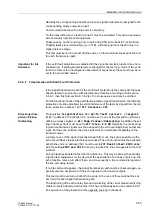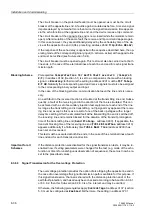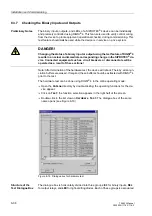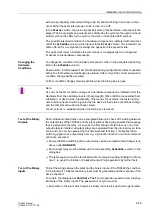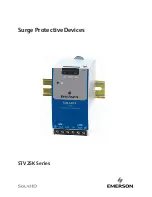
Installation and Commissioning
8-37
7SA522 Manual
C53000-G1176-C119-2
must be set to
21
or
$ODUP2QO\
and/or in address
the setting must be
21
or
$ODUP2QO\
. Naturally, the corresponding output
signals must also be assigned and connected to the transmitter: “
” and/or
“
”. At the receiving end, a binary input is used for the external direct trip
“
”.
A pick up of the overvoltage protection is initiated. This may be achieved with second-
ary test equipment.
It must be checked that the transmitted command is received at the opposite line end,
and produces the desired response there.
This test must be done for both line ends, if transmission in both directions is desired,
otherwise only for the desired transmission direction.
Subsequent to the test it must be ensured that the required functions and, if applica-
ble, pick up thresholds are again set correctly, if they were altered for this test.
8.3.6.4
Transfer trip signal transmission for breaker failure protection and/or stub protection
If the transfer trip command for breaker failure protection or stub protection is to be
transmitted to the remote end, this transmission must also be checked.
To check the transmission the breaker failure protection function is initiated by a
test current (secondary) with the circuit breaker in the open position. Make sure that
the correct circuit breaker reaction takes place at the remote end.
Each transmission path must be checked on lines with more than two ends.
8.3.6.5
Signal Transmission for Internal and External Remote Tripping
The 7SA522 provides the possibility to transmit a remote trip signal to the opposite line
end if a signal transmission path is available for this purpose. This remote trip signal
may be derived from both an internally generated trip signal as well as from any signal
coming from an external protection or control device.
If an internal signal is used, the initiation of the transmitter must be checked. If the sig-
nal transmission path is the same and has already been checked in one of the previ-
ous subsections, it need not be checked again here. Otherwise the initiating event is
simulated and the response of the circuit breaker at the opposite line end is verified.
In the case of the distance protection, the permissive underreach scheme may be
used to trip the remote line end. The procedure is then the same as was the case for
permissive underreach (Sub-section 8.3.6.1 under “Permissive Underreach Trans-
fer”); however the received signal causes a direct trip.
For the remote transmission, the external command input is employed on the receiv-
ing line end; it is therefore a prerequisite that: in address
the setting
'77'L
UHFW7ULS
is set to
(QDEOHG
and that in address
the setting
'77'LUHFW
7ULS
is set to
21
. If the signal transmission path is the same and has already been
checked as part of the previous subsections, it need not be checked again here. A
function check is sufficient, whereby the externally derived command is executed. For
this purpose the external tripping event is simulated and the response of the circuit
breaker at the opposite line end is verified.
Содержание siprotec 7SA522
Страница 20: ...7SA522 Manual C53000 G1176 C119 2 ...
Страница 64: ...7SA522 Manual C53000 G1176 C119 2 ...
Страница 89: ...SIPROTEC 4 Devices 4 25 7SA522 Manual C53000 G1176 C119 2 Figure 4 20 CFC Logic example ...
Страница 408: ...7SA522 Manual C53000 G1176 C119 2 ...
Страница 456: ...7SA522 Manual C53000 G1176 C119 2 ...
Страница 516: ...7SA522 Manual C53000 G1176 C119 2 ...
Страница 620: ...Appendix B 48 ...

